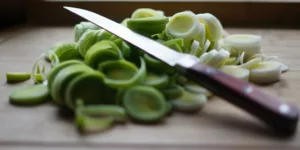Kitchen knife safety tips are the various measures that can be taken to ensure nothing gets cut in the kitchen except food items. Kitchen knife safety is not only about chopping food, it also involves proper cleaning, sharpening and storing of knives.
Kitchen knives are essential tools in the kitchen, that cannot be avoided during any food preparation .However, these knives can turn out to be hazardous if they are not properly handled.
Here are some practical, and useful, tips from Patricia from MyFilletKnife.com.
When chopping
- Ensure that your knuckles and not your fingers are near the knife. This is done by curling your fingers under the hand that is holding the food item you are cutting.
- Concentrate on the task at hand and avoid any interruptions when using the knife.
- Wear gloves that can minimize the risk of getting cut.
Cleaning knives
Cleaning your knives after preparing different food items helps in preventing the spread of bacteria, improves durability of the blades and the proper method can prevent minor accidents that may result from slippery blades.
- The knife should be laid on a flat surface when cleaning
- Use hot water and soap to clean knives after cutting raw poultry or beef. This kills germs
- Clean the knife from the back towards the front.
- Do not leave a dirty knife in a sink with soapy water solution unattended, this can result in an accident in case someone gets their hand into the sink unknowingly.
Sharpening knives
Cutting food with sharp knives requires less pressure and therefore eases up the preparation process. Dull knives are likely to slip off and cause injury. A sharpening stone, steel or a professional sharpener can be used to sharpen knives.
- Hold the blade against the steel at an angle of about 30-degree
- Slide the blade in up and down movement along the steel in easy and gentle strokes
- Ensure both sides are sharpened
- Do not push too hard
To ensure that kitchen knives are always sharp and not blunt, avoid cutting food items on materials such as porcelain, glass or metal.
Once the knives have been sharpened, inform other members of the household on the same so that they take proper handling precautions.
Storing knives
Knives should be stored in places that cannot be reached by kids and where they cannot fall and cause injury.
Some safe places to store kitchen knives include;
- In racks
- In knife sheaths
- Away from open flames
- In a wooden knife blade
- Away from other utensils.
Other kitchen knife safety tips that most people ignore include;
- Knives should not be used for any other purpose apart from the intended purpose i.e. cutting food items in the kitchen. Homeowners use kitchen knives as substitutes for other tools such as screw driver and opening bottle tops. The knives can slip off and cause serious injuries.
- Scrapping food materials from cutting boards will damage the knife. The knife can be blunt or even break its blade.
- Do not carry knives while holding the blade. The handle is meant for holding the knife and the blade should always point downward.
- When passing a knife to someone, do not throw it to them or slide it.Simply place it on a flat surface and let them pick it from there.








